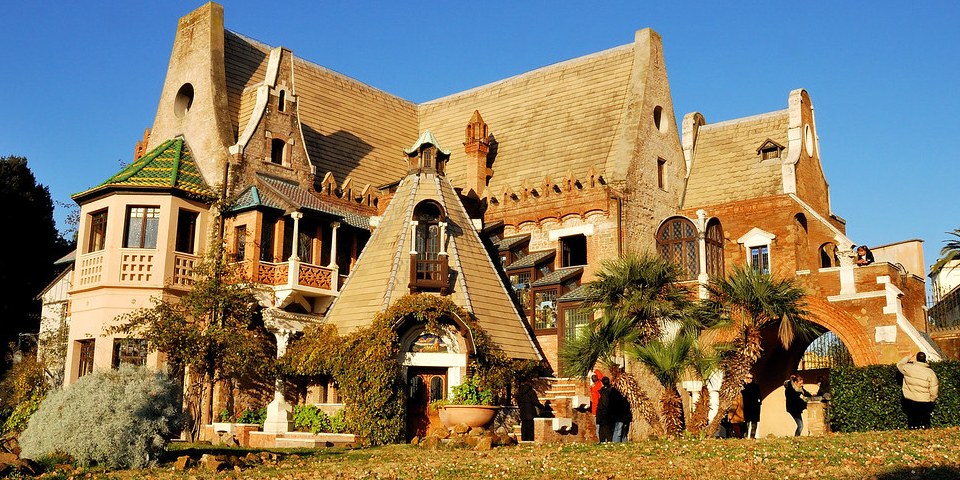

989442 travellers read

| Opening hours |
Sunday:
-
Tuesday:
-
Wednesday:
-
Thursday:
-
Friday:
-
Saturday:
-
|
|---|---|
| Closest bus stops |
|
| Closest subway stations |
|
| Address | Via Nomentana, 70, Roma |
| Website | www.museivillatorlonia.it |
House of the Owls (Casina delle Civette) is a hidden gem of Rome located in Villa Torlonia, boasting many unusual architectural features. Originally, it served as the residence of Prince Giovanni Torlonia the Younger until his death in 1938. It resulted from a series of transformations and additions to the 19th-century “Swiss Cabin”, located at the edge of the park and concealed by an artificial mound, intended as a retreat from the formal atmosphere of the main residence.
Contents
ToggleKnown as the Casina delle Civette, or the Little House of the Owls, this enchanting complex was initially designed in 1840 as a “Swiss cabin” for Prince Alessandro Torlonia. However, it underwent significant alterations, eventually being redesigned in the style of a “mediaeval hamlet” at the request of Prince Giovanni Torlonia the Younger, who lived there until 1938.
The building is a remarkable tribute to Art Nouveau, decorated with stained glass, mosaics, coloured ceramic tiles, mullioned windows, and turrets scattered across its varied rooftops.
Expect to be charmed by its romantic motifs of owls, swans, and peacocks. The nooks and crannies of its beautifully restored interior are a delight to explore—particularly for children. Visitors should note that while entry to the surrounding park is free, tickets for the Casina delle Civette must be purchased at the Villa Torlonia palace, which is located much nearer the main entrance than the House of the Owls itself.
A fire in 1991, along with theft and vandalism, further worsened the already dilapidated condition of the House of the Owls. Its current appearance is the result of a lengthy and meticulous restoration carried out between 1992 and 1997. Thanks to surviving remnants and extensive documentation, the city has regained one of the most distinctive and fascinating buildings of the early 20th century.
In early 20th-century Rome, the imaginative flair of the period gave rise to an exciting modern artistic movement known as Liberty. The centre that fostered this stylistic innovation and experimentation was the workshop of Master Glassmaker Cesare Picchiarini (1871–1943), who is widely recognised for reviving the art of glassmaking.
By around 1910, he had gathered a small but influential circle of artists keen to collaborate with him, including Duilio Cambellotti (1876–1960), Paolo Paschetto (1885–1963), Umberto Botazzi (1865–1932), and Vittorio Grassi (1878–1958).
There is an exhibition by Maria Paola Ranfi entitled “Gioiello Intimo Colloquio.” Created for the 2 June 2019 celebrations at the Italian Embassy in Pakistan, the life-sized masks—crafted from silver, porcelain, and precious stones—pay tribute to Italy and, in particular, the artistic heritage of Venice. They reflect the artist’s homage to the centuries-old culture of the Venetian Republic.
Maria Paola Ranfi’s final creative project, *Mutants*, expresses a protest against environmental degradation and, above all, the modern individual’s inability to protect and shape a sustainable habitat for future generations. Central to this concept—already explored in her acclaimed jewellery series *The Awakening of the Righteous*—are five symbolic animals, regarded as spiritual guides. These creatures embody the ongoing deterioration of the Earth’s ecosystems: air, water, and soil.
These unique jewels are large decorative brooches designed to be worn either centrally or on the side of the bust. They incorporate diamonds, rubies, silver with PV, and pearls.
Author: Kate Zusmann
This website uses cookies. For more info read the cookies policy
RomeItaly.guide © 2025. Created with love by Roman experts and guides.